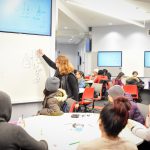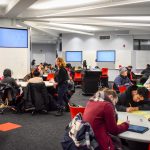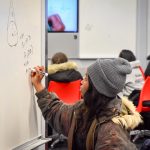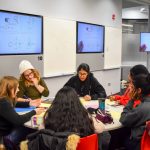New space promotes active learning
Photos: Fan Wang
UIC’s largest active learning classroom opened its doors this semester, giving more students a chance to collaborate in a high-tech environment.
The 120-seat learning environment in 201 Science and Engineering South provides an opportunity for students in math, science and the social sciences to engage in active learning — participating in group work during class time rather than passively listening to lectures. Other active learning classrooms on campus can seat from 24 to 80 students. An open house is set for 8-9:15 a.m. Feb. 26 in SES 201.
“We’re really trying to promote active learning on campus because there’s so much research out there on how it improves learning outcomes,” said David Taeyaerts, associate vice chancellor of learning environments and campus architect. “We realized that we were missing out on some really large introductory courses and that’s where we could really make a huge impact on student success.”
The new classroom in SES features 20 tables that each seat six students. Each table has its own whiteboard and an LCD display panel, where students can display content wirelessly from their personal devices, as well as share their work with classmates around the room. Each table also has push-to-talk microphones so students can amplify their voices across the large space.
“This room is all about student engagement and peer-to-peer learning,” Taeyaerts said.
Martina Bode is among the first to teach in the classroom. Her Calculus II students have used the space to collaborate on worksheets and share their work with the entire class.
“The first day of classes, students were entering the classroom, looking around and saying, ‘Wow, what is this?’” said Bode, clinical professor and director of calculus. “The acoustics in the room are excellent, and when students use the mic, they don’t even have to lean forward or stand up, so students felt comfortable working with me.”
Bode also enjoyed walking around to each table, meeting her new students.
“I was able to connect with the students,” she said. “We are really excited about the room and it’s a dream come true.”
The design of the room is also perfect for physics students, said David Hofman, professor and head of physics. Large introductory physics courses are difficult to teach in traditional lecture halls, he said, because it’s hard to reach individual students when they need help solving challenging problems. Next fall, he said, the physics curriculum will be revamped to focus on active learning.
“You cannot walk through the class and really engage students in the layout of a standard classroom,” he said. “We can now have people walking around, looking over shoulders and helping break down all of the challenges when students get stuck at different levels.
“It’s just going to be transformative. We wanted to incorporate active learning in the revamped curriculum, and we couldn’t really do it without a classroom like this.”
A mural outside the room sets the tone for the active learning space, featuring students collaborating and interconnected circular nodes with icons representing big ideas, technology and more.
“The idea behind active learning is that every student brings knowledge to the table, and by connecting, they are sharing this knowledge,” Taeyaerts said.
The room was designed based on the Office of Campus Learning Environment’s experimental classroom study, input from faculty and students and input from a nationwide benchmarking analysis, Taeyaerts said. Faculty members from math and physics were involved in the design process, he said.






